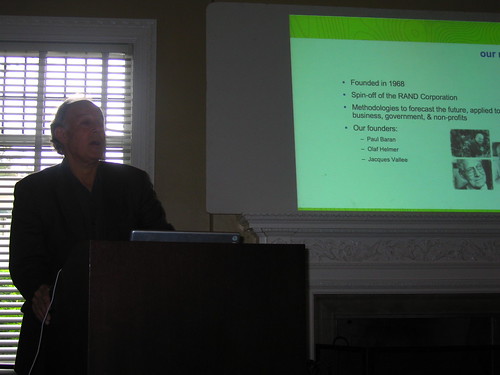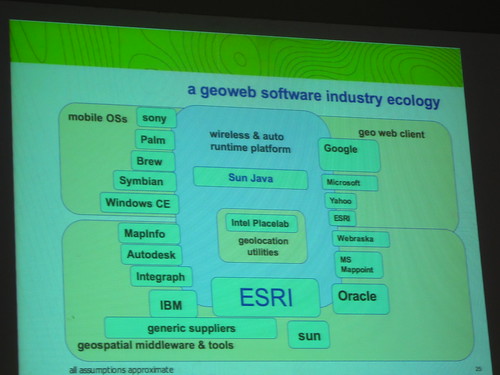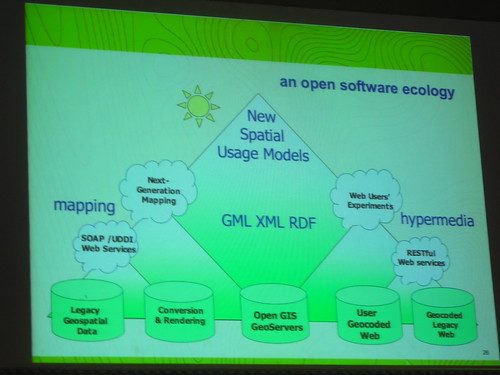From September 2005 to June 2006 a team of thirteen scholars at the The University of Southern California's Annenberg Center for Communication explored how new and maturing networking technologies are transforming the way in which we interact with content, media sources, other individuals and groups, and the world that surrounds us.
This site documents the process and the results.
categories
network infrastructure
French Broadband
One of the interesting developments discussed at last week's IDATE conference is the recent rise of cheap broadband in France (current penetration is about 30%). For example, for 30 euros per month, free.fr offers 20Mb/s internet access (ADSL 2+), unlimited VoIP calls within France, and 75 channels of digital television (including the obvious suspects, plus some eclectic offerings such as Russia's RTR-Planeta and Al Jazeera Children's Channel). An additional 125 digital channels can be had for an extra fee. This also makes video on demand viable. One interesting example is vodeo.tv which distributes about 8000 francophone documentaries for a fee roughly equivalent to what you'll pay to watch "Desperate Housewives" on your iPod.
Flowing with Flock?
Net browsing used to be mostly about just surfing site after site for information. But in the last few years, people have also used the Internet to be networked to each other as well as to produce and share things within [w:networks]. Flock, the latest open source [w:Web 2.0] browser that has just been launched (still in developer preview version, though), seeks to address this new social phenomenon.
Another response to Mike Liebhold on Geospatial Web
See my comment on Mike Liebhold's lecture here.
Response to Michael Liebhold on The Geospatial Web
I posted my remarks on Michael Liebhold's talk on The Geospatial Web here
Michael Liebhold Talk
Service Ecologies and The Geospatial Web

Mike Liebhold is here today to talk on the topic of the Geospatial web.
What does the IFTF do?Brainstorm through possible, plausible, probable and preferred futures. Present a context for understanding the future. Up to clients to develop insights based on the foresights. Foresight to insight actions is the operating principle of the company.
Research areas are sociological impacts of technology.
Some IFTF clients: AMA, Johnson & Johnson, Alstate, Intel, Pepsico, Lego, Kraft, Kodak, Honda, McDonalds.
Methodologies: Mapping, Ethnographic, Expert workshops & interview; Scenario development & analysis; Surveys & quantitative analysis (sort of..); content facilitation; prototyping/artifacts (building objects from the future.)
* US / ICANN vs ITU / UN
* The Chinese future of IPv6
* Economies of scale drive specifications
* The Golden Shield
What happens if the US holds onto ICANN and others want to split off the root server infrastructure?
What is the lesson here? Chinese are buying lots and lots of Nextel, etc., so they can influence technology design by virtue of their force in the economics of design — they can say what they'll buy and when they're buying lots of something, they can shape design and thereby create protocols or variations of protocols independent of task forces.
Platforms: P2P Networks
* Mesh Networks
* Automotive Nets
* Sensor Nets
* Self-configuring Nets
Trend in the future for web-like experiences out in the world. Leads to the Geospatial Web.
What is interesting here? Imaginary world draped over physical world. Long standing area of interest for Mike. Profound new kind of world wide web, hypermedia objects are not just identified by URI or URL but by spatial coordinates — lat/lon/elevation. What are these? Text objects; sounds; images. Enormous amount of cartographic data that should be viewed in situ. Invisible attributes become visible. Sentient landscapes. Context-aware computing. Geoweb Geospatial Ecosystem* Geolocation Techniques
** location-aware software (triangulation)
** location-aware devices (e.g. GPS)
** location-sensing networks (e.g. E911) What is interesting here? General concern with privacy, partially because there aren't open systems for these.
Placelab.org is an alternative, because it's open. Telco carriers have the location info, but they won't make it available because they want to charge you or worse. So the economics of that proposition are not compelling to end users who don't want to feel like they're getting nickel-and-dimed. * devices for augmented perception
** smart phones & PDAs
** automobile computers
** body extensions (pens, cameras, earphone rigs, pens) What is interesting here? Not at all clear how the device ecology will evolve. * location-aware services
** walled gardens (sadly..)
** carrier services
** enterprise servcies
** Google Earth
** MS Virtual Earth
** Sony XYZ — head-mounted video, dashboard graphics. What is interesting here? You may want to hold up a device to see things as you move around, rather than on a downward facing screen. Geoweb Software Industry Ecology
 What is interesting here?Open mapping services allow you to import standard maps into Google Maps — detailed in new book called Google Map Hacks by O'Reilly.
an open software ecology
What is interesting here?Open mapping services allow you to import standard maps into Google Maps — detailed in new book called Google Map Hacks by O'Reilly.
an open software ecology
 What is interesting here? There's a software ecology and an industry ecology and a bit of confusion amongst them. Or maybe it's that the two "ecologies" don't overlap in that the industry ecology does not open up their platforms to the software ecology. Walled garden problem.
geospatial policies
* contextual privacy
What is interesting here? There's a software ecology and an industry ecology and a bit of confusion amongst them. Or maybe it's that the two "ecologies" don't overlap in that the industry ecology does not open up their platforms to the software ecology. Walled garden problem.
geospatial policies
* contextual privacy* freely accessible geolocation APIs
* public geodata services What is interesting here? Interesting practices for creating geodata — individuals, local groups, creating their own maps through grassroot means, and spunky, hacky techniques such as walking/riding with GPSs. Same sort of way that NAVTEQ does, only open. Also, Institute for Applied Autonomy's iSee. Geodata Search * clearinghouses
* gateways
* repositories
* namespaces
* geoweb servers Integrated GIS & Web Hypermedia / Realtime Cubit Cartography
Usage: Computational Grids
* health mapping** epidemiological + environmental maps
** health resources
** risky places
** people at risk
* security
* Geo Demographics
** microzone advertising
* at-risk ecologies
** eco-tourism
** green mapping
** indigenous mapping
* path-making (capturing folkloric knowledge of a place)
* pixel views: fragmenting places and spaces (micro views into a farm field)
* ground truth: empowering people in place (creating your own community information and stories in place)
Technorati Tags: geospatial web, locative media, Service Ecology
blackboard + webct = even worse product
egad....opensource take me away...
Blackboard and WebCT, leading providers of enterprise software and services to the education industry have announced plans to merge. The announcement was made at October 12th at 4 pm EST in a news release posted on PR News wire.
"I have had experience with both companies and view this merger as combining excellence with excellence to advance the e-Learning industry, I also see this combination as a way to break down barriers across the Commonwealth of Massachusetts, and to open the door to new opportunities for collaboration among institutions using different e-learning platforms." - Jack Wilson, President of The University of Massachusetts and current WebCT Vista client.
Made in California: Internet censorship in Mynamar
The New York Times carries an an article on how repressive regimes such as the military-run state of Myanmar use off-the-shelf technology from Sunnyvale, California based Fortinet to filter out dissenting Internet content.

The City Beyond Maps
I've posted my essay "The City Beyond Maps," originally published in Pasajes de Arquitectura y Critica, September, 2003,
to varnelis.net. This article is the final of four articles commissioned by Pasajes to re-examine the relationship of architecture and capital at the start of the millennium. The other three are: Hallucination in Seattle, on Gehry's Experience Music Project, Cathedrals of the Culture Industry, on OMA's competition entry for LACMA, Disney Hall, and Eli Broad, and A Brief History of Horizontality: 1968/1969 to 2001/2002, on 9/11, Archizoom, and FOA's Yokohama Terminal. This essay considers downtown Los Angeles from the perspective of a critical theory of network technology and suggests that, as we search for new theories to understand architecture and culture after postmodernism, it is not the Disney Concert Hall that succeeds Fredric Jameson's Bonaventure Hotel, it is carrier hotel One Wilshire. Read it [here] You may also want to look at Marc Tuters's essay Locative Space: Situated and Interconnected" on this very site. Marc and I are working together this semester and I think it's worth juxtaposing these pieces.
ms double dose
Two big announcements from MS today...mostly likely to try and derail the Apple juggernaut (ie today's vPod announcement). First, MS to pay Real a chunk of money and partner to distribute their online music wares. This is an attempt to displace ITMS as the dominant player in the space. Second, MS and Yahoo have teamed up to take on AOL for instant messaging dominance.
redundant, redundant, redundant
And here you were worried about peer-to-peer leading to the downfall of western civilization (at least that's what the RIAA and MPAA would lead you to believe). Well, it turns out what you really need to worry about is "peering" agreements between the previously unknown (to most people) companies like Cogent and Level 3. These are the guys who run the big fat pipes of the Internet. It turns out that many of them have what are called "peering" agreements wherein they establish direct network connections between them with no money changing hands. In theory their customers get better service (faster network connection, not having to weave through the rest of the network), and simplified architecture.
.
.
